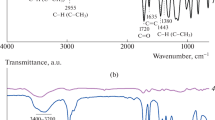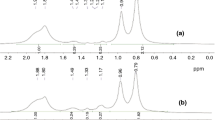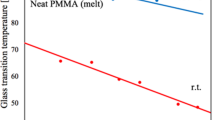Abstract
In this paper, our goal is to improve the understanding of structural control of hybrid materials synthesized by using acid-catalyzed sol–gel reactions of bis-[trimethoxysilylpropyl]amine (BisSi) and 2-hydroxyethyl methacrylate (HEMA) via free radical in a common solvent. Polymer networks compositions were determined by FTIR and 1H-NMR spectroscopy. The thermal properties of the P(HEMA-BisSi) hybrids with different silica content (e.g. 10, 15 and 25 wt%) were determined by thermogravimetric analysis and differential scanning calorimetry. Glass transition temperatures (Tg´s) of P(HEMA-BisSi) networks were also compared with Tg of PHEMA homopolymer. The Tg´ of PHEMA homopolymer was found as 103.74 °C. The thermal stability of these networks was increased with the BisSi content. Scanning electron microscopy images showed that an increase in acid content caused a decrease in the pore size and pore volume as well as in the surface area of the xerogel.








Similar content being viewed by others
References
S. Abraham, S. Brahim, K. Ishihara, A. Guiseppi-Elie, Molecularly engineered p(HEMA)-based hydrogels for implant biochip biocampatibility. Biomaterials 26, 4767–4778 (2005)
M. Assefi, F. Davar, H. Hadadzadeh, Green synthesis of nanosilica by thermal decomposition of pine cones and pine needles. Adv. Powder Technol. 26, 1583–1589 (2015)
D. Azolin, C. Moro, T. Costa, E. Benvenutti, Effects of organic content and H2O/TEOS molar ratio eon the porosity and pore size distribution of hybrid naphthaleneaminepropylsilica xerogel. J. Non-Cryst. Solids 337, 201–204 (2004)
T. Caykara, C. Özyürek, Ö. Kantoglu, B. Erdogan, Thermal behavior of poly(2-hydroxyethyl methacrylate-maleic acid) networks. Polym. Degrad. Stab. 80, 339–343 (2003)
P. Chhabra, R. Gupta, G. Suri, M. Tyagi, G. Seshadri, Studies on development of polymer materials using gamma irradiation for contact and intraocular lenses. Int. J. Polym. Sci. 2009, 01–09 (2009). doi:10.1155/2009/906904
R.O. Costa, W.L. Vasconcelos, Structural modification of poly(2-hydroxyethyl methacrylate)-silica hybrids utilizing 3-methacryloxypropyltimethoxysilane. J. Non-Cryst. Solids 304, 84–91 (2002)
A. Cretu, R. Gattin, L. Brachais, D. Barbier-Baudry, Synthesis and degradation of poly(2-hydroxyethyl methacrylate)-graft-poly(ε-caprolactone) copolymers. Polym. Degrad. Stab. 83, 399–404 (2004)
A.M. Douvas, K. Yannakopoulou, P. Argitis, Thermally-induced acid generation from 18-molybdodiphosphate and 18-tungstodiphosphate within poly(2-hydroxyethyl methacrylate) films. Chem. Mater. 22, 2730–2740 (2010)
O. Foussaier, M. Menetrier, J.-J. Videau, E. Duguet, Polydimethylsiloxane-based ORMOSIL microstructure: correlation with compressive behavior. Mater. Lett. 42, 305–310 (2000)
S.M. Juhasz, Preparation of novel bioactive nano-calcium phosphate-hydrogel composites. Sci. Technol. Adv. Mater. 11, 1–7 (2010)
I.M. Kalogeras, The nature of the glassy state: structure and glass transitions. J. Mater. Educ. 34(3–4), 69–94 (2012)
S. Li, A. Shah, A.J. Hsieh, R. Haghighat, S. Praveen, I. Mukherjee, E. Wei, Characterization of poly(2-hydroxyethyl methacrylate-silica) hybrid materials with different silica contents. Polymer 48, 3982–3989 (2007)
X. Ma, H. Wang, S. Jin, Y. Wu, X.-J. Liang, Construction of paclitaxel-loaded poly(2-hydroxyethyl methacrylate)-g-poly(lactide)-1,2-dipalmitoylsn-glycero-3-phosphoethanolamine copolymer nanoparticle delivery system and evaluation of its anticancer activity. Int. J. Nanomed. 7, 1313–1328 (2012)
T. Metroke, Y. Wang, W.J. van Ooij, D.W. Schaefer, Chemistry of mixtures of bis-[trimethoxysilylpropyl]amine and vinyltriacetoxysilane: an NMR analysis. J. Sol. Sci. Technol. 51, 23–31 (2009)
T. Ogoshi, Y. Chujo, Organic-inorganic polymer hybrids prepared by the sol–gel method. Compos. Interfaces 11(8–9), 539–566 (2005)
M. Rao, J. Gray, B. Dave, Smart glasses: molecular programming of dynamic responses in organosilica sol–gels. J. Sol–Gel Sci. Technol. 26, 553–560 (2003)
B. Reining, H. Keul, H. Hocker, Block copolymers comprising poly(ethylene oxide) and poly(hydroxyethyl methacrylate) blocks: synthesis and characterization. Polymer 43, 3139–3145 (2002)
M. Santi, S. Huang, S. Iannace, L. Ambrosio, L. Nicolais, G. Peluso, synthesis and characterization of a new interpenetrated poly(2-hydroxyethyl methacrylate)-gelatin composite polymer. Biomaterials 17, 1459–1467 (1996)
Z. Sassi, J. Bureau, A. Bakkali, Spectroscopic study of TMOS-TMSM-MMA gels previously identification of the networks inside the hybrid material. Vib. Spectrosc. 28, 299–318 (2002)
C. Wan, M. Li, X. Bai, Y. Zhang, Synthesis and characterization of photoluminescent Eu(III) coordination halloysite nanotube-based nanohybrids. J. Phys. Chem. C 133, 16238–16246 (2009)
F. Wolf, N. Friedemann, H. Frey, Poly(lactide)-block-poly(HEMA) block copolymers: an orthogonal one-pot combination of ROP and ATRP, using a Bifunctional initiator. Macromolecules 42, 5622–5628 (2009)
I. Zareba-Groz, W. Mista, A. Sikora, T. Gotszalk, Textural properties of silica-based organic-inorganic polymer hybrid xerogels. Mater. Sci. Pol. 23(1), 147–158 (2005)
D. Zhu, W.J. van Ooij, Corrosion protection of metals by water-based silane mixtures of bis[trimethoxysilylpropyl]amine and vinyltriacetoxysilane. Prog. Org. Coat. 49, 42–53 (2004)
Acknowledgments
This study was supported by DGEST-4416.11-P. The authors wish to express their sincere thanks to the BUAP-CUV for their guidance and support.
Author information
Authors and Affiliations
Corresponding authors
Rights and permissions
About this article
Cite this article
Salgado-Delgado, R., Bustos-Figueroa, L.A., García-Hernández, E. et al. Poly(2-Hydroxyethyl Methacrylate-Bis[Trimethoxysilylpropyl]Amine) Hybrid Networks. J Inorg Organomet Polym 26, 756–763 (2016). https://doi.org/10.1007/s10904-016-0391-x
Received:
Accepted:
Published:
Issue Date:
DOI: https://doi.org/10.1007/s10904-016-0391-x




